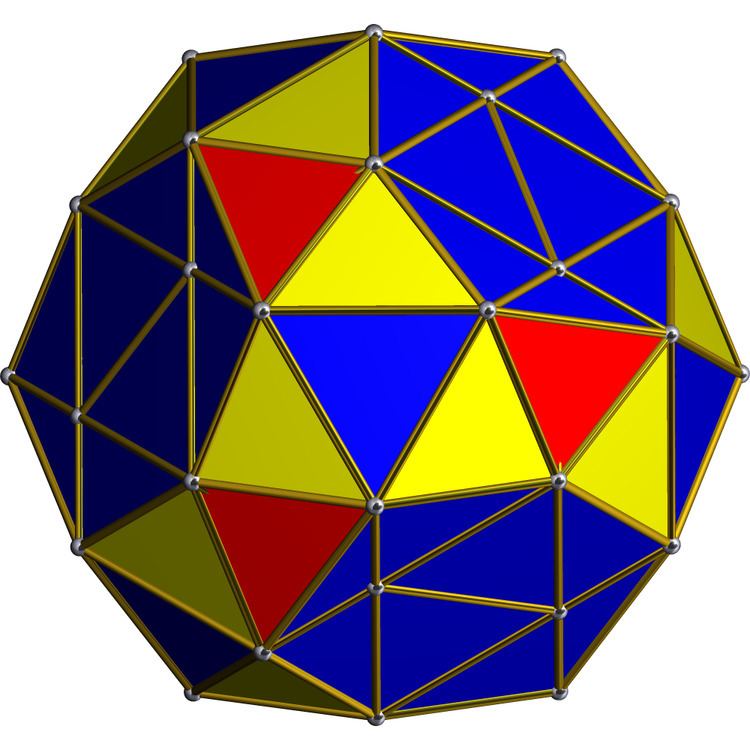 | ||
In geometry, the snub 24-cell or snub disicositetrachoron is a convex uniform 4-polytope composed of 120 regular tetrahedral and 24 icosahedral cells. Five tetrahedra and three icosahedra meet at each vertex. In total it has 480 triangular faces, 432 edges, and 96 vertices.
Contents
Semiregular polytope
It is one of three semiregular 4-polytopes made of two or more cells which are Platonic solids, discovered by Thorold Gosset in his 1900 paper. He called it a tetricosahedric for being made of tetrahedron and icosahedron cells. (The other two are the rectified 5-cell and rectified 600-cell.)
Alternative names
Geometry
The snub 24-cell is related to the truncated 24-cell by an alternation operation. Half the vertices are deleted, the 24 truncated octahedron cells become 24 icosahedron cells, the 24 cubes become 24 tetrahedron cells, and the 96 deleted vertex voids create 96 new tetrahedron cells.
The snub 24-cell may also be constructed by a particular diminishing of the 600-cell: by removing 24 vertices from the 600-cell corresponding to those of an inscribed 24-cell, and then taking the convex hull of the remaining vertices. This is equivalent to removing 24 icosahedral pyramids from the 600-cell.
Coordinates
The vertices of a snub 24-cell centered at the origin of 4-space, with edges of length 2, are obtained by taking even permutations of
(0, ±1, ±φ, ±φ2)(where φ = (1+√5)/2 is the golden ratio).
These 96 vertices can be found by partitioning each of the 96 edges of a 24-cell into the golden ratio in a consistent manner, in much the same way that the 12 vertices of an icosahedron or "snub octahedron" can be produced by partitioning the 12 edges of an octahedron in the golden ratio. This is done by first placing vectors along the 24-cell's edges such that each two-dimensional face is bounded by a cycle, then similarly partitioning each edge into the golden ratio along the direction of its vector. The 96 vertices of the snub 24-cell, together with the 24 vertices of a 24-cell, form the 120 vertices of the 600-cell.
Structure
Each icosahedral cell is joined to 8 other icosahedral cells at 8 triangular faces in the positions corresponding to an inscribing octahedron. The remaining triangular faces are joined to tetrahedral cells, which occur in pairs that share an edge on the icosahedral cell.
The tetrahedral cells may be divided into two groups, of 96 cells and 24 cells respectively. Each tetrahedral cell in the first group is joined via its triangular faces to 3 icosahedral cells and one tetrahedral cell in the second group, while each tetrahedral cell in the second group is joined to 4 tetrahedra in the first group.
Symmetry
The snub 24-cell has three vertex-transitive colorings based on a Wythoff construction on a Coxeter group from which it is alternated: F4 defines 24 interchangeable icosahedra, while the BC4 group defines two groups of icosahedra in a 8:16 counts, and finally the D4 group has 3 groups of icosahedra with 8:8:8 counts.
Conversely, the 600-cell may be constructed from the snub 24-cell by augmenting it with 24 icosahedral pyramids.
Related polytopes
The snub 24-cell can be obtained as a diminishing of the 600-cell at 24 of its vertices, in fact those of a vertex inscribed 24-cell. There is also a further such bi-diminishing, when the vertices of a second vertex inscribed 24-cell would be diminished as well. Accordingly this one is known as the bi-24-diminished 600-cell.
The snub 24-cell is also called a semi-snub 24-cell because it is not a true snub (alternation of an omnitruncated 24-cell). The full snub 24-cell can also be constructed although it is not uniform, being composed of irregular tetrahedra on the alternated vertices.
The snub 24-cell is the largest facet of the 4-dimensional honeycomb, the snub 24-cell honeycomb.
The snub 24-cell is a part of the F4 symmetry family of uniform 4-polytopes.
